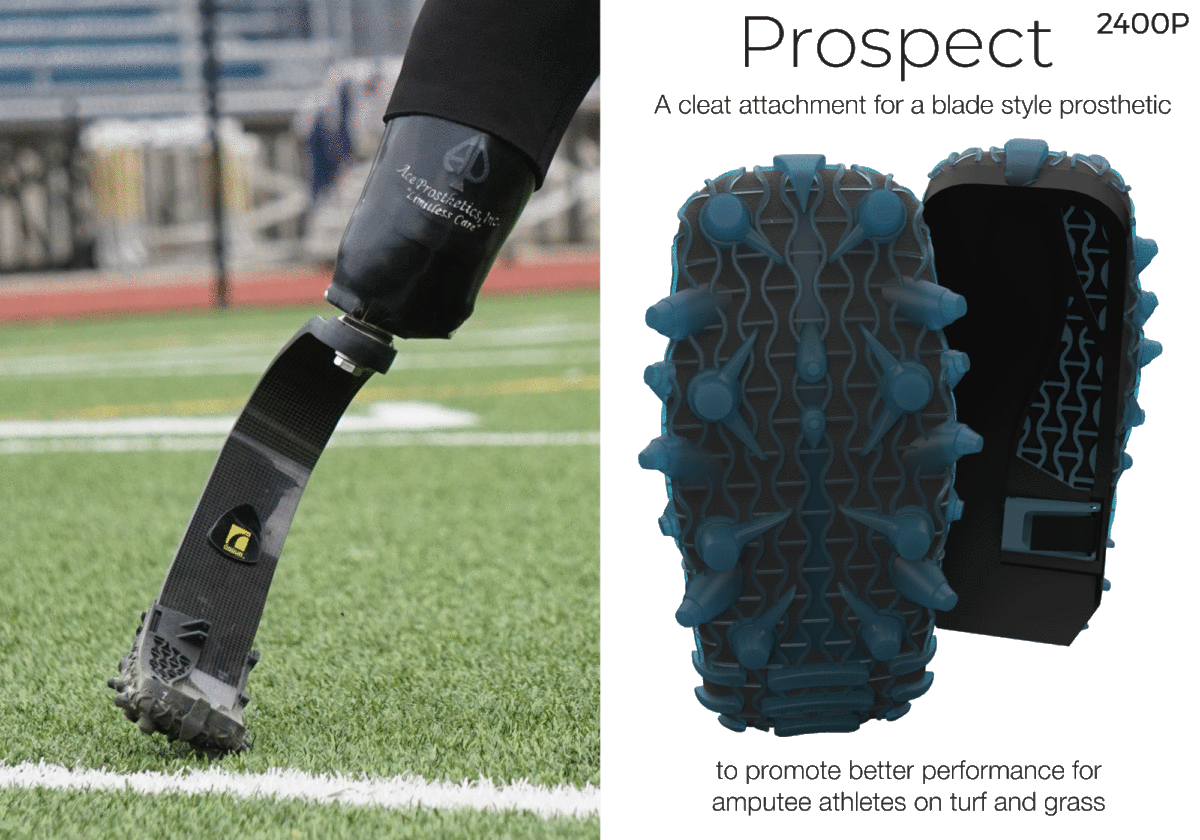RESHAPE18 | sensing materialities
wearable technology category
Prospect
Designer: Weston Rivell, Josiah Harris

Prospect: Prosthetic Blade Cleat
Prospect is a cleat attachment for a blade-style running prosthetic. It serves the demand created by athletes who are missing a part of their leg above or below their knee and play field sports at a high level. This is a growing trend demonstrated by people such as Kody Kasey, an American football player formerly at Georgetown College; Koni Dole, a former American football player at Montana State University; and Noelle Lambert, a former lacrosse player at University of Massachusetts Lowell. All of these athletes are lower limb amputees and recently graduated from highly competitive colleges where they played field sports using a blade-style prosthetic. The best method to date for these players to adapt their blade to grass or synthetic turf is the do-it-yourself approach. They cut the sole off of a cleat and use athletic tape to attach the cleat to the bottom of their blade. This is still very ineffective because while the blade provides the necessary flexion of the ankle to recreate a sprinting action, it does not recreate the pronation and supination (also known as lateral rollover) of the ankle which allows an athlete to plant their foot flat when they push off from the ground at an an angle. This ability to plant flat when pushing off at an angle is key to retaining traction when changing directions at high speeds. So currently, when these athletes try to evade an opponent or chase down the ball they are at a much higher risk of losing their footing than anyone else on the field.

This seriously affects their ability to compete at these high levels which is unacceptable. Blade-style prosthetics do not have this lateral ankle rollover because they are meant for the track where the gradual curves mean you are always pushing off either straight or only at small angles. Now that these athletes are repurposing these blades to the field this shortcoming is apparent. Prospect solves this lack of ankle rollover and traction by providing an adaptive midsole which allows a more organic interface between the blade and the ground. Additionally, the cleats are placed in a pattern developed to work for the mechanics of a blade-style prosthetic which is much different than that of a human foot. We developed Prospect with the help of Kody Kasey, one of the most notable amputee collegiate athletes who play field sports to date. But Kody is part of a growing population of amputees who are finding any way to get back onto the field and play the sports that bring them joy. Currently there are an estimated 2.2 million amputees in the United States. Of that, 172,300 US amputees have a major lower limb amputation, are between the ages of 18 and 45, and do not have a vascular disease. This population is those who are applicable to use a blade style prosthetic and are of the age and circumstance that makes them fit to engage in sports. Additionally, this The projected cost of producing each cleat with a combination of mainly injection molding and 3d printing would be $40 with a $110,000 initial investment in tooling. Selling these prosthetics for $500 (reduced for the consumer through insurance companies) would mean it would turn a profit of just over $683,000 if it were able to reach just 1% of the viable US market. And that is not including amputees under the age of 18 nor amputees who are living outside of the US. The dissemination strategy would involve marketing the cleats by supplying them to amputee athlete camps which are growing in popularity that focus on a variety of sports such as NubAbility. Additionally, they would be marketed to prosthetists as a simple, non-bespoke solution for patients who wish to play field sports.


